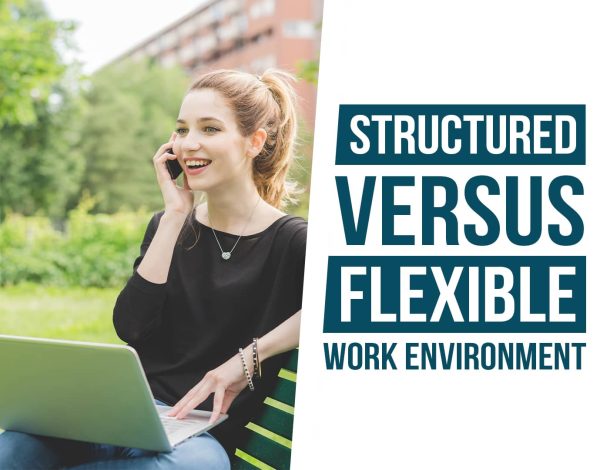Are you a job seeker looking for the ideal working environment? Or an employee wanting to know if your current setup works best for you?
As it turns out, there are two major types of work settings: structured and flexible. Research shows that each has its own set of advantages, making it difficult to decide which one fits better in certain situations. Struggling to decide which is more suitable? In this blog post, we’ll be taking a closer look at both structured and flexible environments to help you make an informed decision!
What is a Structured Work Environment?
A structured work environment is one that is well-organized and planned out, offering employees a clear set of expectations for their roles and responsibilities.
It can be easy for work to become chaotic and overwhelming, especially when there are multiple projects going on at once. But with a structured work environment, everyone knows exactly what they need to do and when they need to do it, allowing for more efficient and productive work processes.
Additionally, a structured environment can lead to better communication among team members, as everyone is on the same page and working towards the same goals. Ultimately, a structured work environment can help to reduce stress, increase focus, and ultimately lead to greater success for individuals and for organizations as a whole.
What is a Flexible Work Environment?
Have you ever heard of a flexible work environment? It’s a workplace where the traditional 9-to-5 workday is no longer the norm. Instead, employees have the freedom to set their own schedules, work from home or other remote locations, and even choose the projects they want to work on. The key idea behind a flexible work environment is to provide employees with an ideal balance between work and personal life.
The benefits are numerous, including increased job satisfaction, better work-life balance, and improved productivity. Employers are starting to take notice, and many are embracing this new way of working. So, if you’re looking for a career that allows for more independence and autonomy, a flexible work environment may be just what you need!
Pros of a Structured Work Environment
A structured work environment can be beneficial for both employers and employees. For employers, it provides a clear set of expectations and goals that employees must meet. This ensures that everyone is on the same page and working towards the same objectives. For employees, a structured work environment provides structure and stability. It allows them to focus on their tasks without worrying about distractions or unexpected changes in their job duties. Additionally, it can help to create an atmosphere of trust between employer and employee, as there is a clear understanding of what is expected from each party.
Job satisfaction is also typically much higher in a structured work environment, as managers or executives are better able to offer support and coaching to their teams.
Overall, having a structured work environment can lead to increased productivity, better communication between team members, and improved morale among staff. It also helps to ensure that everyone is held accountable for their actions and that tasks are completed in a timely manner.
Cons of a Structured Work Environment
A structured work environment has long been seen as the epitome of professionalism and order. However, there are certain cons to such a rigid work system that cannot be overlooked.
For instance, a structured work environment does not allow much room for creativity or flexibility. Employees may become robotic, and their productivity could soon decrease. The strict deadlines, set rules, and the constant demand for efficiency can make it difficult for employees to feel comfortable at work.
Additionally, individuals may feel undervalued and overworked, leading to dissatisfaction in their work and in their personal lives.
Pros of a Flexible Work Environment
Having a flexible work environment is becoming increasingly attractive to employees and employers alike. One major pro is the ability to have a better work-life balance. With the option to work from home or to have flexible hours, employees can more easily manage their personal commitments and have a healthier work-life balance.
Another pro is increased productivity. Studies have shown that workers who have the option to work flexibly are able to better manage their time, which results in increased productivity levels. Additionally, a flexible work environment allows for more diverse hiring options, as location and physical presence become less important factors.
Overall, implementing a flexible work environment can lead to happier, more productive employees and a more diverse and successful business.
Cons of a Flexible Work Environment
While many employees dream of a flexible work environment – one where they can work remotely, adjust their hours, and have some control over their work-life balance – there are certainly downsides to this type of arrangement.
With less face-to-face interaction, it can be harder to build relationships with colleagues and supervisors, and there may be a decreased sense of camaraderie among team members.
Additionally, working remotely can blur the lines between work and personal life, leaving employees feeling like they’re never quite able to switch off. Finally, a flexible work environment can result in less supervision, which can be great for self-starters but can also lead to decreased productivity and accountability.
Examining which works best for different types of employees
The modern work environment has seen a rise in the popularity of flexible work arrangements. While some employees thrive in a flexible work environment that allows them to set their own schedule and work from home, others prefer the structure and routine of a traditional office setting. It is important for employers to examine each employee’s individual work style and productivity levels in order to determine which work environment is best suited for them.
A flexible work environment may work well for those who are self-motivated and can manage their time effectively, while a structured work environment may be optimal for those who require guidance and supervision to excel. Ultimately, the key to success lies in finding the right balance between flexibility and structure in the workplace.
It is clear to see that both structured and flexible work environments have their pros and cons. Being aware of these can help you create a workplace that works best for the employees, customers, and type of business you operate.
Furthermore, understanding individual skill sets and utilizing a blend of both environments can be beneficial in ensuring success. Most importantly, it is crucial to provide an inviting and comfortable atmosphere while allowing employees to explore their creativity, as this ultimately ensures more productive collaboration between staff members. Flexibility gives teams room to grow, but having an organized structure in place ensures everyone is on the same page and keeps projects moving forward.
Striking the balance between flexibility and structure within your workplace will help ensure that each employee achieves their highest potential.







